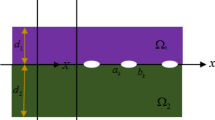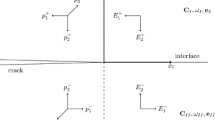Abstract
Actuators, sensors, micro- and nano-electromechanical systems and other piezoelectirc components are generally constructed in block form or as a thin laminated composites. The study of the integrity of such materials in their various forms and small sizes is still a challenge nowadays. To gain a better understanding of these systems, this work presents a crack surface contact formulation that includes friction and thus makes it possible to study the integrity of these advanced materials under more realistic crack surface multifield operational conditions. The dual boundary element method (BEM) is used for modeling frictional crack surface contact on piezoelectric solids in the presence of electric fields, further taking into account the electrical semipermeable boundary conditions on the crack. The formulation uses contact operators over the augmented Lagrangian to enforce contact constraints on the crack surfaces. The BEM reveals to be a very suitable methodology for these interface interaction problems because it considers only the boundary degrees of freedom, what makes it possible to reduce the number of unknowns and to obtain accurate results with a much lower number of elements than formulations based on the standard finite element method or the eXtended finite element method. The capabilities of this methodology are illustrated by solving some benchmark problems.














Similar content being viewed by others
References
Kuna M (2010) Fracture mechanics of piezoelectric materials where are we right now? Eng Fract Mech 77:309–326
Zhang P, Du C, Tian X, Jiang S (2018) A scaled boundary finite element method for modelling crack face contact problems. Comput Methods Appl Eng 328:431–451
Lei J, Zhang C (2018) A simplified evaluation of the mechanical energy release rate of kinked cracks in piezoelectric materials using the boundary element method. Eng Fract Mech 188:36–57
Merville PH (1977) Fracture mechanics of brittle materials in compression. Int J Fract 13:532–534
Comninou M, Dundurs J (1979) On the frictional contact in crack analysis. Eng Fract Mech 12:117–123
Cordes RD, Joseph PE (1994) Crack surface contact of surface and internal cracks in a plate with residual stresses. Int J Fract 66:1–17
Ballarini R, Plesha ME (1987) The effects of crack surface friction and roughness on crack tip stress fields. Int J Fract 34:195–207
Weber W, Willner K, Kuhn G (2010) Numerical analysis of the influence of crack surface roughness on the crack path. Eng Fract Mech 77:1708–1720
Zang WL, Gudmundson P (1991) Frictional contact problems of kinked cracks modelled by a boundary integral method. Int J Numer Methods Eng 31:427–446
Liu SB, Tan CL (1992) Two-dimensional boundary element contact mechanics analysis of angled crack problems. Eng Fract Mech 42:273–288
Chen T-C, Chen W-H (1998) Frictional contact analysis of multiple cracks by incremental displacement and resultant traction boundary integral equations. Eng Anal Bound Elem 21:339–348
Phan A-V, Napier JAL, Gray LJ, Kaplan T (2003) Symmetric-Galerkin BEM simulation of fracture with frictional contact. Int J Numer Methods Eng 57:835–851
Phan A-V, Napier JAL, Gray LJ, Kaplan T (2003) Stress intensity factor analysis of friction sliding at discontinuity interfaces and junctions. Comput Mech 32:392–400
Weber W, Kolk K, Willner K, Kuhn G (2011) On the solution of the 3D crack surface contact problem using the boundary element method. Key Eng Mater 454:11–29
Dolbow J, Möes N, Belytschko T (2001) An extended finite element method for modeling crack growth with frictional contact. Comput Methods Appl Eng 190:6825–6846
Liu F, Borja RI (2008) A contact algorithm for frictional crack propagation with the extended finite element method. Int J Numer Methods Eng 76:1489–1512
Mueller-Hoeppe DS, Wriggers P, Loehnert S (2012) Crack face contact for a hexahedral-based XFEM formulation. Comput Mech 49:725–734
Nanthakumar SS, Lahmer T, Zhuang X, Zi G, Rabczuk T (2016) Detection of material interfaces using a regularized level set method in piezoelectric structures. Inverse Probl Sci Eng 24:153–176
Nejati M, Paluszny A, Zimmerman R (2018) A finite element framework for modeling internal frictional contact in three-dimensional fractured media using unstructured tetrahedral meshes. Comput Methods Appl Eng 306:123–150
Pan E (1999) A BEM analysis of fracture mechanics in 2D anisotropic piezoelectric solids. Eng Anal Bound Elem 23:67–76
Xu XL, Rajapakse RKND (2000) A theoretical study of branched cracks in piezoelectrics. Acta Mater 48:1865–1882
Rajapakse RKND, Xu XL (2001) Boundary element modeling of cracks in piezoelectrics solids. Eng Anal Bound Elem 25:771–781
García-Sánchez F, Sáez A, Domínguez J (2005) Anisotropic and piezoelectric materials fracture analysis by BEM. Comput Struct 83:804–820
Groh U, Kuna M (2005) Efficient boundary element analysis of cracks in 2D piezoelectric structures. Int J Solids Struct 42:2399–2416
Muñoz-Reja MM, Buroni FC, Sáez A, García-Sánchez F (2016) 3D explicit-BEM fracture analysis for materials with anisotropic multifield coupling. Appl Math Model 40:2897–2912
Wünsche M, Zhang C, García-Sánchez F, Sáez A, Sladek J, Sladek V (2011) Dynamic crack analysis in piezoelectric solids with non-linear electrical and mechanical boundary conditions by a time-domain BEM. Comput Methods Appl Mech Eng 200:2848–2858
Wünsche M, Sladek J, Sladek V, Zhang C, García-Sánchez F, Sáez A (2011) Dynamic crack analysis in piezoelectric solids under time-harmonic loadings with a symmetric Galerkin boundary element method. Comput Methods Appl Mech Eng 84:141–153
García-Sánchez F, Rojas-Díaz R, Sáez A, Zhang C (2007) Fracture of magnetoelectroelastic matrials using boundary element method (BEM). Theor Appl Fract Mech 47:192–204
Rojas-Díaz R, Denda M, García-Sánchez F, Sáez A (2007) Dual BEM analysis of different crack face boundary conditions in 2D magnetoelectroelastic solids. Eur J Mech A Solid 47:192–204
Wang B-L, Mai Y-W (2007) Applicability of the crack-face electromagnetic boundary conditions for fracture of magnetoelectroelastic materials. Int J Solids Struct 44:387–398
Loboda V, Sheveleva A, Lapusta Y (2014) An electrically conducting interface crack with a contact zone in a piezoelectric bimaterial. Int J Solids Struct 51:63–73
Sheveleva A, Lapusta Y, Loboda V (2015) Opening and contact zones of an interface crack in a piezoelectric bimaterial under combined compressive-shear loading. Mech Res Commun 63:6–12
Govorukha V, Kamlah M, Loboda V, Lapusta Y (2016) Interface cracks in piezoelectric materials. Smart Mater Struct 25:023001
Rodríguez-Tembleque L, Buroni FC, Sáez A (2015) 3D BEM for orthotropic frictional contact of piezoelectric bodies. Comput Mech 56:491–502
Rodríguez-Tembleque L, Buroni FC, Sáez A, Aliabadi MH (2016) 3D coupled multifield magneto-electro-elastic contact modelling. Int J Mech Sci 107:36–53
Rodríguez-Tembleque L, Sáez A, Aliabadi MH (2016) Indentation response of piezoelectric films under frictional contact. Int J Eng Sci 107:36–53
Zhang X, Wang Z, Shen H, Wang QJ (2018) An efficient model for the frictional contact between two multiferroic bodies. Int J Solids Struct 130–131:133–152
Hong HK, Chen JT (1988) Derivations of integral equations of elasticity. ASCE J Eng Mech 114:1028–1044
Portela A, Aliabadi MH, Rooke DP (1992) The dual boundary element method: effective implementation for crack problems. Int J Numer Methods Eng 33:1269–1287
Alaimo A, Milazzo A, Orlando C, Messineo A (2013) Numerical analysis of piezoelectric active repair in the presence of frictional contact conditions. Sensors 13:4390–4403
Barnett DM, Lothe J (1975) Dislocations and line charges in anisotropic piezoelectric insulators. Phys Stat Sol (b) 67:105–111
Alart P, Curnier A (1991) A mixed formulation for frictional contact problems prone to Newton like solution methods. Comput Methods Appl Mech Eng 92:353–375
Christensen PW, Klarbring A, Pang JS, Strömberg N (1998) Formulation and comparison of algorithms for frictional contact problems. Int J Numer Methods Eng 42:145–173
Kikuchi N, Oden JT (1988) Contact Problems in Elasticity: A Study of Variational Inequalities and Finite Element Methods. SIAM, Philadelphia
Laursen TA (2002) Computational Contact and Impact Mechanics. Springer, Berlin, Heidelberg
Wriggers P (2002) Computational Contact Mechanics. Wiley, Chichester
Joli P, Feng Z-Q (2008) Uzawa and Newton algorithms to solve frictional contact problems within the bi-potential framework. Int J Numer Methods Eng 73:317–330
Rodríguez-Tembleque L, Abascal R, Aliabadi MH (2012) Anisotropic wear framework for 3D contact and rolling problems. Comput Methods Appl Mech Eng 241:1–19
Rodríguez-Tembleque L, Abascal R (2013) Fast FE-BEM algorithms for orthotropic frictional contact. Int J Numer Methods Eng 94:687–707
Saez A, Gallego R, Dominguez J (1995) Hypersingular quarter-point boundary elements for crack problems. Int J Numer Methods Eng 38:1681–1701
Acknowledgements
This work was supported by the Ministerio de Ciencia e Innovación, Spain, through the research projects: DPI2014-53947-R and DPI2017-89162-R, which were co-funded by the European Regional Development Fund (ERDF).
Author information
Authors and Affiliations
Corresponding author
Additional information
Publisher's Note
Springer Nature remains neutral with regard to jurisdictional claims in published maps and institutional affiliations.
Rights and permissions
About this article
Cite this article
Rodríguez-Tembleque, L., García-Sánchez, F. & Sáez, A. Crack-face frictional contact modelling in cracked piezoelectric materials. Comput Mech 64, 1655–1667 (2019). https://doi.org/10.1007/s00466-019-01743-x
Received:
Accepted:
Published:
Issue Date:
DOI: https://doi.org/10.1007/s00466-019-01743-x




